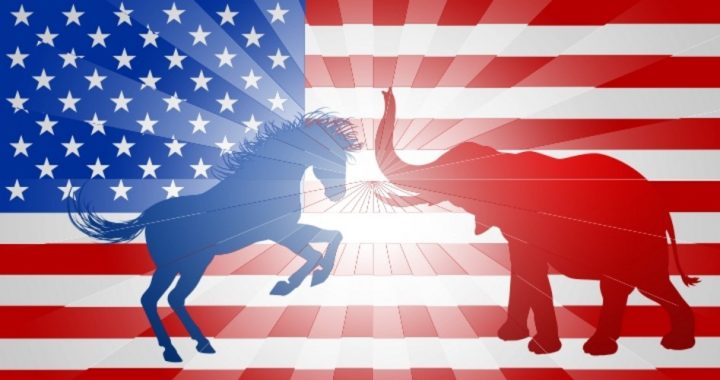
“We learn from history that we do not learn from history,” observed German philosopher Georg Hegel. That the same can be said of the short-term history known as current events brings to mind the much ballyhooed midterm “blue wave,” a phenomenon that two new polls indicate may be blue wishful thinking.
As American Thinker’s Thomas Lifson writes, “I think it is obvious that the 90% of the media operating as adjuncts of the Democratic Party intend to discourage Republicans so deeply that they do not turn out and vote…. Republicans are doomed! That’s the media’s story, and they’re sticking to it.” But Rasmussen — the most accurate polling outfit during the historic 2016 election — has just released a poll saying otherwise. As it reported Wednesday:
For the first time in months, Democrats and Republicans are tied on the Rasmussen Reports Generic Congressional Ballot.
The latest telephone and online survey finds that 44% of Likely U.S. Voters would choose the Democratic candidate if the elections for Congress were held today. Another 44% would now opt for the Republican. Three percent (3%) prefer some other candidate, and eight percent (8%) are undecided. (To see survey question wording, click here.)
A week ago, Democrats held a 48% to 41% lead on the generic ballot.
If Rasmussen doesn’t convince, there’s always the Tampa Bay Times, which, as Lifson noted, “is not exactly a Republican rag.” As it reported Thursday, “Nearly 1.4 million Floridians have already voted in next Tuesday’s primary…. Republicans have strong leads over Democrats in both voting by mail and in early voting. Statewide, Republicans account for 47 percent of all votes, and Democrats 42 percent.”
This is significant because there are actually more Democrats than Republicans in Florida — approximately 250,000 more. So while all the enthusiasm (and red-hot anger) are supposed to be on the left, the GOP is outperforming the Democrats turnout-wise even more than the 47/42 ratio indicates.
Of course, Republicans are more likely to vote in general; of even greater significance, they’ve enjoyed an average midterm turnout advantage since 1978 of three percentage points relative to their registration numbers.
Yet this advantage is reduced to one percent under GOP presidents, and there are significantly more registered Democrats in the country as a whole. Thus, slightly fewer Democrats turning out relative to registration numbers still amounts to more of them voting in raw numbers.
So what does this confusing picture indicate for Election Day? In the Senate, only 35 of the 100 seats are up for grabs, 26 of which are held by Democrats. So the Democrats’ chances of taking control are vanishingly small; in fact, the Republicans may even pick up one to three seats and improve upon their current 51-49 advantage.
The House of Representatives is a different matter. All 435 seats are contested every election, but only 48 are rated “competitive” in 2018 according to the New York Times. Nonetheless, the Democrats need flip only 24 to win a majority, and, the Times states, 25 are in “Clinton territory.”
But what of the polling? The historic 2016 election should give pause. After all, a businessman and TV reality star became the first person to ever capture the presidency without having held political office or having been in the military. Moreover, he did it despite polls, pundits, politicians, and paid prevaricators (forgive the redundancy) saying he had no chance.
This is instructive. I stated prior to the 2016 election that if it weren’t for the prospect of vote fraud, I’d be sure Trump would win. I was convinced he was under-polling and that this was for a simple reason: political correctness.
The more politically incorrect a position or candidate, the less likely people are to admit they support him. Even now in many quarters some people are afraid to reveal their affinity for the president.
The question is, however, with much of the populace and all the pseudo-elites having moved so far left they’ve left the country, is this phenomenon manifesting itself even with garden-variety GOP candidates? Maybe, maybe not — but it is my sense that the Republicans are under-polling to some degree.
Of course, the election is still a bit more than two months away, an eternity in political terms. A lot will happen between now and then, with Mueller, machinations, and media Machiavellianism being the order of the day. As for the last factor, UCLA political science professor Tim Groseclose conducted research showing that media “bias aids Democratic candidates by about 8 to 10 percentage points in a typical election.” He could be understating the case, too.
But that’s the bottom line. Were the mainstream media honest (an alternate-universe notion, I know), the party of tearing down statues, beating up political opponents, vandalizing property, selling baby body parts, and America “was never that great” wouldn’t stand a chance. Yet media bias is intense, and if this isn’t remedied, there’s the distinct possibility that the republic will be toppled right after the last Confederate monument.
Photo: ChrisGorgio/iStock/Getty Images Plus



